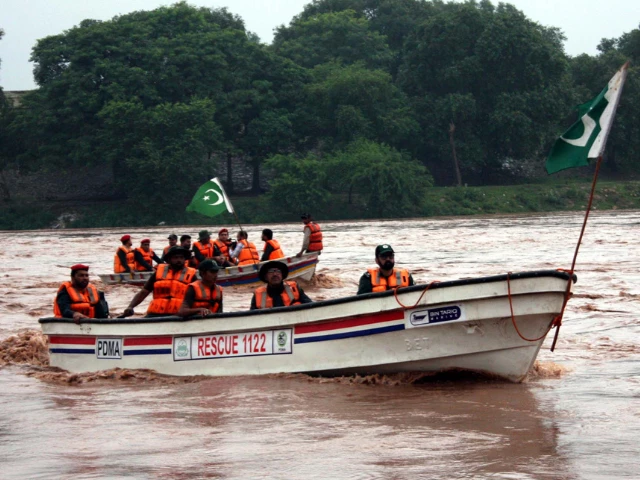In response to the serious floods in progress in the District of Narowal, the local administration requested help from the Pakistani army, while the increase in flood waters continues to unwind large expanses from the region.
The floods were triggered by the discharge of approximately 250,000 brackets of the Ravi river in Kot Nainan, submerging large expanses of agricultural and residential land. Simultaneously, high water levels in the DEK Nulllah added to devastation, putting additional pressure on local emergency efforts.
Planning Minister Ahsan Iqbal, in a position on X on Tuesday, said the situation in the Narowal district had reached emergency levels. He confirmed that if the district administration was actively engaged in rescue and rescue operations, the severity of the crisis required the deployment of army staff.
ضلع ناروا ATU, کوٹ نیناں کے مقام پر Bear طغیانی جاری ہے۔
ضلعی انتظامیہ امدادی کاروائیوں میں مصروف ہے، تاہم سیلاب کی
– Ahsan Iqbal (@betterpakistan) August 26, 2025
“The administration is working in the field, but the severity of the floods has led us to request the support of the Pakistani army,” he said. He urged citizens to remain vigilant, to avoid unnecessary movements in affected areas and to prioritize their security. The minister also announced that he went to Narowal to assess the situation on the ground.
Meanwhile, the Disaster Management Authority (PDMA) province warned that the province – including the big city of Lahore – is confronted with a “very high high” flooding “, led by heavy monsoon rains and India’s decision to release water from two dams.
According to the PDMA, India had opened all the doors of the dam, releasing excess water in the delight. This development follows a warning issued the day before concerning a possible discharge from the Madhopur dam which fulfills rapidly, also affecting the Ravi river system.
“The flood situation is serious,” said Irfan Ali Kathia, an official of the Punjab disasters management authority. “The next 48 hours will be critical.”
Learn more: PM commands rapid evacuations while floods have an impact on Sutlej, Ravi and Chenab
The National Disaster Management Authority (NDMA) previously assessed that satellite imagery showed that the dam was already 97% full – a level to which the water discharge becomes imminent.
India regularly performs such versions when tanks exceed capacity; However, the proximity of the two nuclear nations and persistent post-conflict tensions have increased sensitivity. All the floods charged to Indian actions could further reduce fragile relations.
A source from the Indian government said that the second alert did not refer to a specific dam. Intense precipitation, added the source, caused renewed communication with Pakistan via diplomatic channels, ostensibly for humanitarian reasons to help avoid a disaster affecting the two countries.
Mass evacuations in progress
Authorities increased evacuations – more than 190,000 Punjab residents were moved, including nearly 35,000 people who left voluntarily after the flood warnings on August 14, according to national officials.
The villages near the Ravi, Sutlej and Chenab rivers are being eliminated, with the help of the army. While the current floods along these rivers range from high -level means, strong additional precipitation are expected in the Punjab and the Pakistani cashmere in the next 12 to 24 hours.
“Sixteen villages remain at risk of immediate flood,” said assistant commissioner Saba Asghar Ali during a site visit to Pasrur near the Indian border. Rescue camps have been created with provisions for food, medicine, sanitation and other necessities.
The Minister of Punjab irrigation, Kazim Raza Pirzada, observed that “climate change has intensified precipitation in our basins of the eastern river compared to the past”.
PMD provides persistent rains, risk of flooding
The Pakistan Meteorological Department (PMD) plans on Wednesday the rains, the wind and the Thonders widespread in the northeast of Punjab and the cashmere, with isolated precipitation expected elsewhere in the center and southern Punjab, the Haut Khyber-Pakhtunkhwa and the northeast and the south of Balutchistan.
Heavy showers can trigger landslides and mud shifts in hilly regions of cashmere – including Rawalakot, Poonch and Mirpur – and urban floods in low cities like Narowal, Siackot, Gujranwala and Lahore.
Residents were invited to remain cautious because intense weather conditions can have an impact on low structures, posts, display panels and vehicles.
In response to the climbing of the threat, the Punjab police inspector, Dr. Usman Anwar, placed the police forces alert. He led teams from the whole province to help rescue and evacuation operations, especially in low villages and subjects to the floods bordering rivers and streams.
The supervision agents (RPOS and DPO) were personally responsible for overseeing field efforts, coordinating closely with district administrations and rescue agencies.
Regular patrols are underway in the affected areas, and the police ensure the safety of emergency camps and people displaced by floods. “The protection of lives, goods and essential effects of citizens will be ensured at all costs,” said the IGP.
Since the start of the monsoon at the end of June, the deaths linked to the floods in Pakistan reached 802, with almost half of half in August only. Other regions are also affected; Gilgit-Baltistan is struggling with an accelerated glacial fusion, and Karachi was partially overwhelmed by sudden floods last week.




